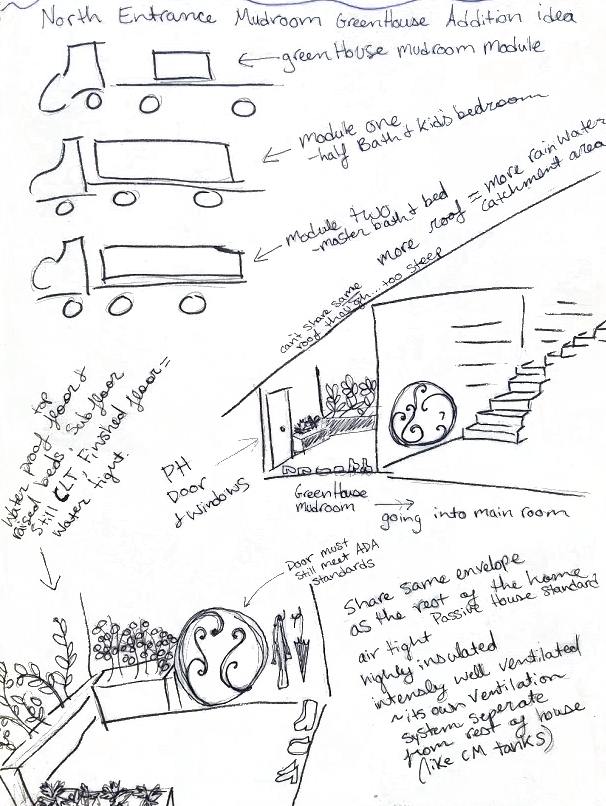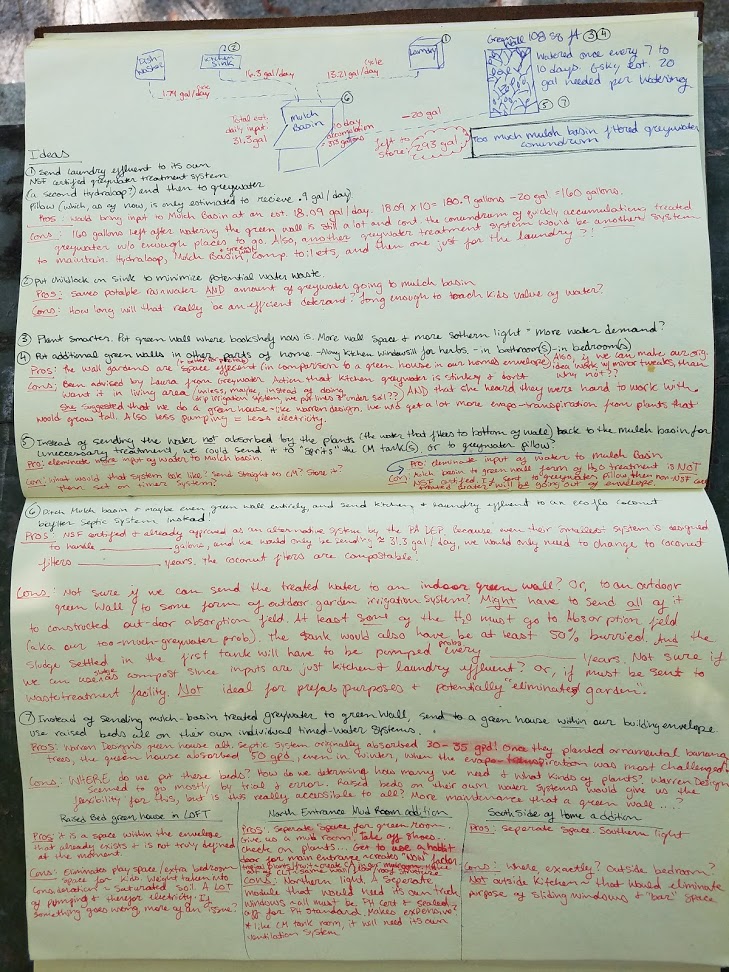Brainstorm for the Too-Much-Mulch-Basin-Filtered-Greywater Conundrum
Dear Readers,
You see that crazy scribble scrabble in that image down below?
So, without further ado…
This is our problem…

Some of you may already be familiar with this one of many issues with The Seed. To briefly sum it up, our mulch basin will end up filtering more greywater on a daily basis (about 30 gallons) than the indoor green wall needs in a week (about 20 gallons). You can read more about the conundrum in its entirety here.2
The ideas that resulted from a morning wading through vexing greywater are as follows:
1.) Send laundry effluent to its own NSF certified greywater treatment system (a second Hydraloop?) and then to the greywater pillow.
Pros: This would bring the input to the mulch basin at an estimated 18.09 gallons per day, while also diverting some more greywater to the greywater pillow. In our current design and with our current water usage estimates, the greywater pillow will only be receiving about 1 gallon per day of treated greywater from the Hydraloop. This is unfortunate since we had intended to use that water for outdoor non-potable purposes (irrigate the garden…wash the dog…)
Cons: 18.09 gallons per day still adds up to a whole heck of a lot of water. 18.09 gpd to the mulch basin x 10 days = 180.9 gallons. Minus 20 gallons to irrigate the green wall, still leaves 160 gallons to be stored away just waiting to be used. Also, another greywater treatment system would be another system to maintain and think about. We would have: Hydraloop, mulch basin, green wall, composting toilet tank, and then a system just for the laundry water?! That’s a lot.
2.) Put child lock on sink to minimize potential water waste.
Pros: Saves potable rainwater and the amount of greywater going to the mulch basin.
Cons: How long will that really be an efficient deterrent? Long enough to teach our children the value of water?
3.) Plant smarter. Put the green wall where the bookshelf now is. More wall space and more southern light = higher water demand?
4.) Put additional green walls in other parts of the home. Along the kitchen window sill for herbs? In bathrooms? In bedrooms?
Pros: The green walls are more space efficient and better for prefabrication mindsets in comparison to a greenhouse in our home’s envelope (which, is another idea…). Also, if we can make our original idea work with minor tweaks, then why not?
Cons: We have been advised by an experienced greywater reuse enthusiast and advocate that kitchen greywater is stinky and that you don’t want it in your living area (unless, maybe, and this is my idea…that instead of doing a drip irrigation system~ which I believe is what some of the green walls we were looking into use~ we could put irrigation lines about 3 inches or so under the topsoil??). That same individual also said that green walls have a reputation of being hard to work with, and they suggested that instead we do a greenhouse within our home’s envelope (much like this couple, here). With a greenhouse we would get a lot more evapo-transpiration from plants that would grow tall. It would also mean less pumping, which means less electricity.
5.) Instead of sending the water not absorbed by the plants (the water that filters to the bottom of the wall) back to the mulch basin for unnecessary treatment, we could send it to “spritz” the clivus multrum composting tanks to keep the composting process moist (a ‘spritzer’ is required in the clivus multrum design).
Pros: Eliminate more input of water to the mulch basin.
Cons: What would that system look like? Send water straight to the composting tanks? Store it? Then set on timer system?
5~continued) ….or, send that ‘not-absorbed-by-plants’ water to the greywater pillow?
Pros: Eliminate that input of water to the mulch basin.
Cons: The greywater treatment provided by the mulch basin to the green wall is not NSF certified. If we send that water to the greywater pillow, then non-NSF certified treated water will be going out of our home’s envelope.
6.) Ditch the mulch basin and maybe even the green wall entirely, and send the kitchen and laundry effluent to an Ecoflo coconut biofilter septic system instead!
Pros: The Ecoflo is already NSF certified and approved as an alternative wastewater treatment system by the PA DEP. Because their systems are made to handle all of the effluent coming from a household (including the toilets), and we will only be sending kitchen and laundry effluent to it, we would hardly ever have to change the coconut filters or pump the sludge from the settlement tank. The coconut filters are also totally compostable…
Cons: After water is treated by the Ecoflo, I’m not sure we can send the treated kitchen and laundry water to an indoor green wall? Or, to an outdoor green wall/ to some form of outdoor garden irrigation system? Might have to send all of it to a constructed out-door absorption field. At least some of the water must go to an absorption field~ aka, the too-much-mulch-basin-filtered-greywater problem. The tank would also have to be at least 50% buried. And the sludge settled in the first tank will have to be pumped at some point, even if it is minimal and only, like, once every 20 years. We are also not sure if we can use that sludge as compost since the inputs are just kitchen and laundry effluent? Or, if the sludge must be sent to a wastewater treatment facility. This idea is not ideal for prefab purposes. And it potentially eliminates the whole ‘garden’ thing.
7.) Instead of sending mulch basin treated greywater to the green wall, we can send it to a greenhouse within our home’s building envelope. We could use raised beds with their own individual timed water systems.
Pros: Warren Design’s greenhouse alternative septic system originally absorbed 30-35 gallons of greywater per day! Once they planted ornamental banana trees, the greenhouse absorbed 50 gallons per day, even in winter, when the evapo-transpiration was most challenged.
Cons: WHERE do we put these beds? How do we determine how many we need and what kinds of plants? Warren Design seemed to go mostly by trial and error. Raised beds on their own timed water systems would give us the flexibility for this (in the event that one garden bed needed maintenance and the water had to be turned off to that particular bed, the other beds could still keep on chugging water). BUT, is this really accessible to all? More maintenance than a green wall…?
WHERE DO WE PUT THE BEDS?
Raised bed greenhouse in the loft space
Pros: It is a space within the envelope that already exists and is not truly defined at the moment.
Cons: Eliminates the potential play space/ extra bedroom space for kids. Weight also needs to be taken into consideration~ saturated soil. A lot of pumping would be necessary, and therefore electricity. If something goes wrong, more of an issue?

Raised Bed Concept. This sketch is awful, but you just might get the idea I am playing with when you squint real hard at the raised bed diagram. It looks even better if you let your eyelashes muddle up your sight and your eyelids twitch.
North entrance mudroom addition
Pros: Would be a separate space for the green room. And it would give us a mudroom! Take off shoes…check on the plants…we could use a round hobbit door for our main entrance then since it would already technically be within the home’s envelope and would not have to meet Passive House standard! We could grow plants that give both food and ornamental value (but mostly any and all food possible). Make the module addition the same as the rest of the house since all will share the same envelope~ CLT.
Cons: Northern light. A separate module that would need its own truck. Windows must all be Passive House certified and the whole greenhouse well sealed and ventilated for Passive House standard. Like the clivus multrum composting tank, it will need its own ventilation system. More expensive than a green wall?

My beautiful sketch of my dream greenhouse mudroom with hobbit door.
South side of home addition
Pros: Separate space. Southern light.
Cons: Where, exactly? Outside bedroom? Not outside the kitchen~ that would eliminate the purpose of sliding windows and the whole “bar”/counter space.
~
As you may have noticed, the day ended with me really taking a liking to the idea of a greenhouse mudroom with a hobbit door. William is still pondering it. All ponderings aside, I think it is perfect. Hobbits do love all things that grow…
Your babbling befuddled brainstormer and Bilbo Baggins’ barefooted believer,
Shelby Aldrich
1. Literally. Any. Thoughts. Even if it’s some random tid-bit about what you ate for breakfast. It would still be a welcome distraction from the problematic greywater we are drowning in. However, if the thought is indeed about what you are digesting from this morning…you may not get a response. But please do know it is still greatly appreciated.
2. Like I said, trying to keep it brief…
4 Comments
Submit a Comment
© 2020 Sustaining Tree
© 2020 Sustaining Tree


Is their any way that it legally can be used on another property nearby that might want it for watering etc of their own?
Hey Aunt Rose! Thanks again for reading, and suggestions 🙂 If we find someone who needs it for their interior plants, I don’t see why we couldn’t! We will have to ask around. We were hoping to use more of the water outdoors, but we need it be cleaned and treated to NSF standards with a tested system, so our neighbors would need indoor plants… but it’s worth asking them!
Always gotta plan for a mudroom!
Yep, I think that’s the direction we’re headed! Not only will it help us keep the house clean (and treat our greywater, and grow food), but it could also act as a vestibule!